Health
Food Planning
-
1kg of butter/coconut oil
-
1.75kg grass fed ground beef (525-560g dehydrated)
-
1.5kg veggies (250-300g dehydrated)
-
1kg of lean grass fed beef, sliced thin for jerky (300-350g dehydrated)
-
200g dried, powdered cream (milk powder/coconut milk powder are sugar heavy substitutes)
-
350g nuts
-
200g dark chocolate
-
200g cheese
-
250g salami
Day 19 – August 15th 2017
07:15 Camp at the most northern small lake in the valley west of Unna Ruskkas
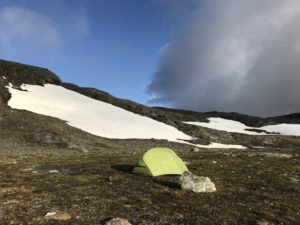
It’s been a cold night, I’ve been wrapped up in my sleeping bag wearing t-shirt and socks and still never got really warm. The wind and rain stopped at some point during the second part of the night and it all went quite up here. This got me some deeper sleep which feels amazingly good this morning!
Right now there’s some wind, no rain and a few specks of blue sky are visible through the clouds. I even caught a tiny little ray of sunshine right of the
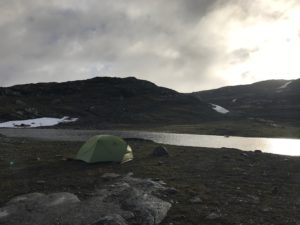
bat when going out first thing in the morning.
Hopefully these are signs that the weather is changing preferably, yet still I made the decision to spend the next night by the cabin in Hukejaure.
I had this weird dream of entering the changing room of a gym I trained at years ago, still wearing all my hiking gear. After undressing I went to the sauna and the moment I opened that door, I woke up here in my tent…
Not really being into dream works at all, I still interpret this one as a clear message from my subconscious to go somewhere and get warmed up!
Actually I’m gonna make this day as easy on myself as I can. I’ve been hiking every day for 18 days without a rest day, averaging almost 20km/d over mostly rather rough ground. The last few nights I haven’t slept my best due to the rough weather, having to get out in the middle of the night to secure the tent with rocks against the wind didn’t help at all, and I feel more tired than I would like.
I know that the next few days after tomorrow are gonna be physically tougher than anything I’ve done so far this tour and so I just want to be as well prepared as I can.
21:00 Camp at Hukejaure cabin
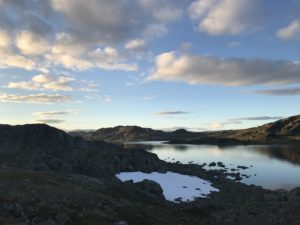
Today in the afternoon we had a shift in weather and right now the sky’s blue, the sun just went behind the mountains and the temperature is still at +9C. Last night down here it was +4, which means two or more degrees less at the additional elevation I camped at. No wonder that, with the impact of the wind, I had a hard time getting warm.
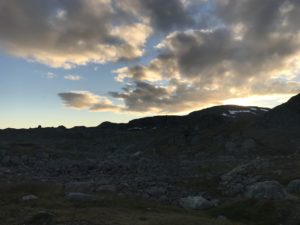
I got started just after 10 this morning, for the first time with a rather moist tent in my backpack. The 10km down to Hukejaure were as easy and smooth as anything can be up here, wind still rough and cold and a few pretty decent rain showers hitting me on the way.
In just two and a half short hours I’d made the trip and went inside for a coffee before putting the tent up to dry in my favorite camp site here.

After coffee and a chat with the cabin host I started taking care of my equipment, wet rain gear got hung up to dry, socks and underwear washed and shoes cleaned and dried. Then some wood chopping and water hauling for the sauna before I fired it up and spent well over an hour just relaxing in the heat. Wow, was that good after literally being cold for two days and nights!
My left calf is still slightly swollen yet much better than the days before.

Olle, the cabin host had gone fishing and was successful, bringing home a huge trout. Having half of it himself left the other half to be shared between myself and two other guests at the cabin. Around 100g of super fresh trout file fried in ghee became an awesome starter for my dinner!
The extra protein seams to have kicked me slightly out of ketosis, though, which was perfectly worth it. I’m pretty sure I’ll be right back there when I wake up tomorrow.
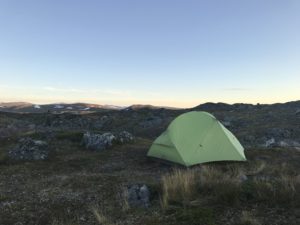
Not much more to report from this day, it’s a tired and very content hiker sitting here in his tent ready for a good night’s sleep. Air is pretty warm and it is quite, no wind shaking the tent and no splashing from raindrops falling. There’s been a few nights since I had an equally peaceful evening!
The journey continues, please leave a comment to tell me what You think and share this with friends and loved ones who might benefit or be interested!
By leaving Your name and email in the box below You get notification of futures posts and news!
Keto Hiker is becoming a reality!
Just under three weeks from now I start a hike that´s developed into a “N=1 scientific experiment”, meaning we do a study of just one subject, me!
I go into the north Swedish mountains for 4 weeks carrying all my provisions from start to be able to control nutrition and consume only ketogenic food. In collaboration with an endocrinologist in Stockholm we do extended blood work before and after.
During the entire tour I’ll be measuring with a Ketonix meter, Michel Lundell has been kind enough to sponsor the project with his latest model and Christofer Kelly from Nourish Balance Thrive is contributing their MCT powder and a couple of DUTCH tests as well as supporting with knowledge.
The basic idea is to take a rather over averagely healthy 46 year old male (that´s me) and put him in a more or less hunter/gatherer situation (except I carry my food instead of killing it along the way) for just over four weeks.
No planned social interactions, no connectivity (that´s no FB, email, cell phone connection… not even snail mail) – just moving through beautiful nature and following the natural rhythm of the body.
Eat when hungry, sleep when tired, move daily, rest as much as needed. Detached from civilization and connecting back with our origin, in a safe and relaxed way using a familiar environment to really remove any stressors as much as humanly possible.
We naturally expect any not so good markers to be reversed and the good ones turning out even better!
So, needless to say I´m stoked and looking forward to see the results of this adventure, stay tuned, check out the short video and, please share with people You know who might be interested or benefit!
Again, please leave a comment to tell me what You think and share this with friends and loved ones who might benefit or be interested!
By leaving Your name and email in the box below You get notification of futures posts and news!